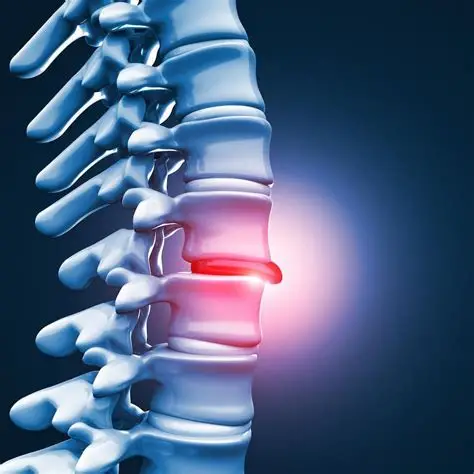What is Herniated Disk Or Slipped Disc?
Herniated disc or slipped disc is a problem that occurs in the rubbery cushions or discs which lie between the vertebrae bones that form the spine. A spinal disc has a soft, jellylike center known as the nucleus fibrosis surrounded by a tougher, rubbery exterior known as the annulus fibrosis. Certain movements may also cause a slipped disc. A disc can slip out of place due to excessive strain on the lower back, resulting in a slipped disc. A herniated disc occurs when some of the nuclei are pushed out through a tear in the annulus, this can occur in any part of the spine resulting in irritation of the nerve.
Symptoms OF Herniated Disk Or Slipped Disc
Herniated disc or slipped disc can occur at any part of the spine, from the neck to the lower back. The lower back is the most common area for a herniated disc. Symptoms vary from person to person few of the symptoms are listed below:
- Pain and numbness, in one side of the body
- Pain radiating to the arms or legs
- Pain aggravates at night or with certain movements
- Pain aggravates after standing or sittingea
- Pain while walking short distances
- Muscle weakness
- Tingling, aching, or burning sensations in the affected area
Causes of Herniated Disk Or Slipped Disc
A slipped disc occurs when the annulus of the outer ring becomes weak and the inner part moves out. A disc can slip out of place, due to the following reasons
- Old age
- Twisting or turning to lift an object
- Lifting a very large, heavy object can place strain on the lower back
- A physically demanding job
- Accidents and injuries
- Overweight
- Weak muscles
- Sedentary lifestyle
Diagnosis Of Herniated Disk Or Slipped Disc
Physical examination: Physical examination is done to look for the source of the pain and discomfort. Also involves checking the nerve functions and muscle strength, and whether the pain is felt while moving or touching the affected area. Aggravating and relieving factors are noted with medical history.
Magnetic resonance imaging (MRI): Magnetic resonance imaging (MRI) scan helps to show the location of the disk and the affected nerves.
X-rays: The Ely's test is a physical test used to assess rectus femoris spasticity or tightness. The patient lies prone and the therapist stands next to the patient, at the side of the leg that is to be tested. One hand is placed on the lower back, the other hand holds the leg at the heel. Then flex the knee passively, the heel should touch the buttocks. For comparison test both sides. The test is positive if the heel cannot touch the buttocks, and the hip of the tested side rises from the table, the patient feels pain or tingling in the back or legs.
Discograms: Discogram involves injecting dye into the center of the disc, this helps to show cracks in the disc. It shows whether a herniated disc is exerting any pressure on the spinal cord and nerves.
Myelogram: Myelogram is done by injecting dye into the spinal fluid and then taking an x-ray image.
Treatment Of Herniated Disk Or Slipped Disc
Medications: Anti-inflammatory, Analgesics, muscle relaxers, opioids.
Note: Medication should not be taken without the doctor's permission.
Surgery: In a few cases, where pain doesn't subside for a prolonged period, surgery is recommended to relieve the pressure on the nerve endings.
Physiotherapy Treatment Of Herniated Disk Or Slipped Disc
Thermotherapy: Thermotherapy is used to promote blood flow and remove toxins.
Cryotherapy: Cryotherapy is used as it reduces inflammation and pain..
Ultrasound therapy: Ultrasound uses sound waves to stimulate the affected area and thus improves blood flow to the part.
Collar: Collar can be used for short-term support for the neck or lower back.
Transcutaneous electrical stimulation (TENS): Transcutaneous electrical stimulations (TENS) promotes gentle relaxation.
Interferential therapy: Interferential therapy is used to reduce pain and inflammation.
Strengthening and stabilization exercises: These exercises improve core muscle strength and support for the back. For a sore back strengthening exercises are done for the trunk and all layers of the core muscles which helps to support the low back and prevent excessive strain through the discs.
Stretching exercises: Stretching exercises are done to improve the flexibility of the back muscles.
Traction: Traction reduces the weight on spinal discs, helps alleviate pressure on the affected nerve, and thus relieves pain.
Laser therapy: Laser therapy helps to enhance the healing process, decrease pain and increase mobility.
Manipulation and mobilization: Manipulation and mobilization techniques are used to break the adhesions, properly align the bones and thus improve mobility.
Balance exercises: Balance exercises are taught for awareness to show how the back should be while moving during various activities.
Patient Education
The patient is advised to avoid the activities which aggravate the symptoms like forward bending and prolonged sitting can increase the pressure on the disc and thus aggravate the condition. Lifting heavy objects, sudden twisting and turning movements that lay stress on the back should also be avoided.


